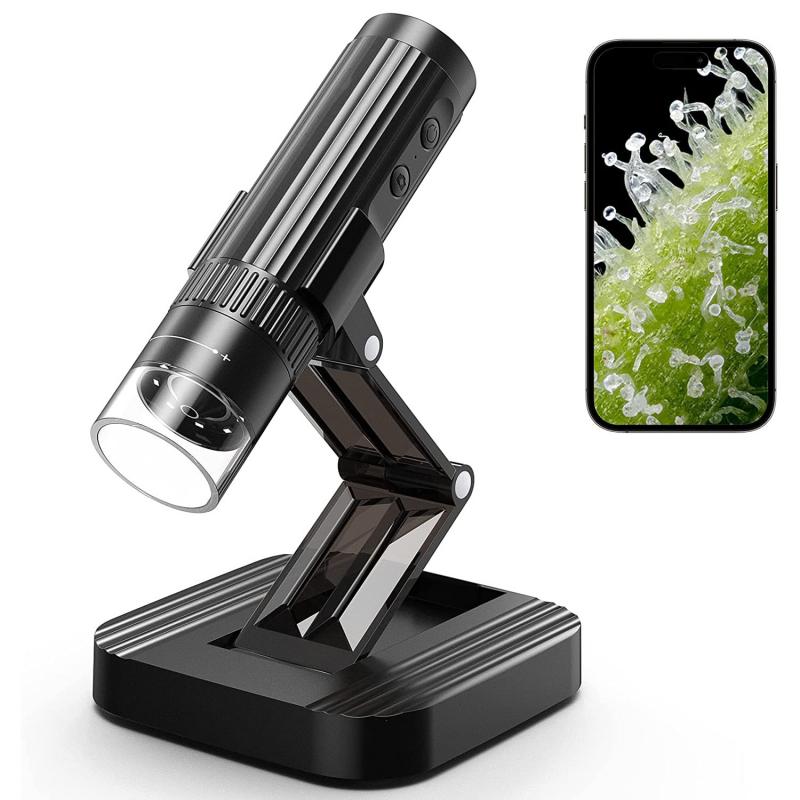What Do Chloroplasts Look Like Under A Microscope ?
Under a microscope, chloroplasts appear as small, oval-shaped structures with a green color. They are typically around 2 to 10 micrometers in length and 1 to 3 micrometers in width. Chloroplasts have a double membrane, with the inner membrane forming a series of folds called thylakoids. These thylakoids are stacked on top of each other to form grana, which are interconnected by stroma lamellae. The grana contain the chlorophyll pigments responsible for capturing light energy during photosynthesis. The stroma, which surrounds the grana, contains enzymes and other molecules involved in the synthesis of carbohydrates. Overall, the distinct shape and green color of chloroplasts make them easily identifiable under a microscope.
1、 Chloroplast structure and organization in plant cells
Under a microscope, chloroplasts appear as small, oval-shaped structures within plant cells. They are typically green in color due to the presence of chlorophyll, the pigment responsible for photosynthesis. Chloroplasts are double-membraned organelles, with an outer membrane that surrounds an inner membrane. The space between these two membranes is known as the intermembrane space.
Inside the inner membrane, the chloroplast contains a gel-like substance called stroma. The stroma is where many of the biochemical reactions of photosynthesis occur. It contains enzymes, DNA, ribosomes, and other molecules necessary for the synthesis of carbohydrates.
Within the stroma, there are also stacks of membranous structures called thylakoids. These thylakoid stacks are known as grana (singular: granum). The thylakoids are interconnected and form a network throughout the chloroplast. They contain chlorophyll molecules and other pigments that capture light energy during photosynthesis.
The arrangement and organization of chloroplasts within plant cells can vary depending on the cell type and the plant species. In general, chloroplasts are found in the mesophyll cells of leaves, where they are most abundant. They can also be present in other green tissues, such as stems and immature fruits.
Recent research has shed light on the dynamic nature of chloroplasts. It is now known that chloroplasts can move within plant cells, changing their position in response to light intensity and direction. This movement is facilitated by a network of actin filaments and motor proteins. Additionally, chloroplasts can undergo fusion and fission events, allowing for the exchange of genetic material and proteins between chloroplasts within a cell.
In conclusion, under a microscope, chloroplasts appear as small, green, oval-shaped structures within plant cells. They have a double-membrane structure, with an inner membrane enclosing a gel-like stroma and interconnected thylakoid stacks. The organization and movement of chloroplasts within plant cells are dynamic processes that contribute to their function in photosynthesis.

2、 Ultrastructure of chloroplasts: thylakoids, stroma, and inner membrane
Under a microscope, chloroplasts appear as small, oval-shaped structures with a green coloration. They are typically around 2 to 10 micrometers in length and 1 to 3 micrometers in width. The green color is due to the presence of chlorophyll, the pigment responsible for capturing light energy during photosynthesis.
The ultrastructure of chloroplasts reveals several distinct components. The most prominent feature is the thylakoid system, which consists of flattened, membrane-bound sacs called thylakoids. These thylakoids are arranged in stacks called grana, and they contain the pigments and proteins necessary for light absorption and the conversion of light energy into chemical energy.
The space surrounding the thylakoid system is called the stroma. The stroma is a dense fluid that contains enzymes, DNA, ribosomes, and other components necessary for the synthesis of carbohydrates and other molecules during photosynthesis. It also plays a role in the regulation of various metabolic processes within the chloroplast.
The inner membrane of the chloroplast surrounds the stroma and separates it from the cytoplasm of the cell. This membrane is selectively permeable and controls the movement of molecules in and out of the chloroplast.
Recent research has provided further insights into the ultrastructure of chloroplasts. Advanced microscopy techniques have revealed the dynamic nature of thylakoid membranes, showing that they can undergo structural changes in response to environmental conditions. Additionally, studies have highlighted the presence of protein complexes within the thylakoid membranes that are involved in the assembly and maintenance of the photosynthetic machinery.
In conclusion, under a microscope, chloroplasts appear as small, green structures with an intricate ultrastructure. The thylakoid system, stroma, and inner membrane are the key components that enable chloroplasts to carry out photosynthesis and produce energy for the plant. Ongoing research continues to uncover new details about the organization and function of chloroplasts, deepening our understanding of these vital organelles.

3、 Chloroplast morphology and variations across different plant species
Chloroplasts are the organelles responsible for photosynthesis in plant cells. Under a microscope, chloroplasts appear as small, oval-shaped structures with a double membrane. The outer membrane is smooth, while the inner membrane is folded into stacks of flattened sacs called thylakoids. These thylakoid stacks are known as grana, and they are interconnected by thin tubules called stroma lamellae.
The thylakoid membranes contain the pigments chlorophyll a and b, which are responsible for capturing light energy during photosynthesis. These pigments give chloroplasts their green color. The grana provide a large surface area for the pigments to capture sunlight, while the stroma lamellae connect the grana and allow for the exchange of materials between them.
Chloroplast morphology can vary across different plant species. Some plants have chloroplasts that are more elongated or irregularly shaped, while others may have larger or smaller chloroplasts. Additionally, the number of grana and the arrangement of thylakoids within the chloroplasts can also differ.
Recent research has revealed that chloroplast morphology can be influenced by various factors, including light intensity, temperature, and nutrient availability. For example, plants grown under high light conditions tend to have more grana and smaller chloroplasts, which may enhance their ability to capture and utilize light energy efficiently. Furthermore, studies have shown that chloroplast morphology can also be influenced by genetic factors, suggesting that there may be specific genes involved in regulating chloroplast shape and structure.
In conclusion, chloroplasts under a microscope appear as oval-shaped structures with a double membrane, containing stacks of thylakoids called grana. The morphology of chloroplasts can vary across different plant species and can be influenced by environmental and genetic factors. Further research is needed to fully understand the mechanisms underlying chloroplast morphology and its functional implications in photosynthesis.

4、 Chloroplast pigments and their role in photosynthesis
Under a microscope, chloroplasts appear as small, oval-shaped structures with a double membrane. They are typically around 2 to 10 micrometers in length and contain a green pigment called chlorophyll, which gives them their characteristic color. Chloroplasts are found in the cells of plants, algae, and some protists, and they play a crucial role in photosynthesis.
Photosynthesis is the process by which plants convert sunlight, carbon dioxide, and water into glucose and oxygen. Chloroplasts are the site of this important biochemical reaction. Within the chloroplasts, chlorophyll molecules capture light energy and use it to power the synthesis of glucose. This process occurs in specialized structures called thylakoids, which are stacked together to form grana. The grana are connected by stroma lamellae, which contain enzymes and other molecules necessary for photosynthesis.
Recent research has shed light on the organization and function of chloroplasts. It has been discovered that chloroplasts are not static structures but are highly dynamic and can change their shape and position within the cell in response to environmental cues. This dynamic behavior allows chloroplasts to optimize their exposure to light and enhance photosynthetic efficiency.
Furthermore, studies have revealed that chloroplasts are not limited to their role in photosynthesis. They also participate in other important cellular processes, such as the synthesis of amino acids, lipids, and hormones. Chloroplasts are involved in the regulation of plant growth and development, as well as in responses to stress and defense against pathogens.
In conclusion, under a microscope, chloroplasts appear as small, oval-shaped structures containing chlorophyll. They are the key organelles responsible for photosynthesis in plants and algae. Recent research has highlighted the dynamic nature of chloroplasts and their involvement in various cellular processes beyond photosynthesis. Understanding the structure and function of chloroplasts is crucial for unraveling the complexities of plant biology and improving agricultural practices.






































